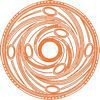Geology and archaeology of Bolsena. A new view on Etruscan civilization
The town of Bolsena, of remote Etruscan origin, rises on one of the four major volcanic calderas that form the Lake of Bolsena[i]. The Etruscan Velzna (Latin Volsinii), the ancient settlement of Bolsena, was intentionally built as a sacred centre on an important eruptive cone, obviously not still active, but bearing its original volcanic morphology. This must have been of primary importance for the Etruscans because it represented, in their conception, a “sign” of definite sacredness or, rather, of a hierophany of the hidden gods of the telluric underground.
All of this is comprehensible if we bear in mind that for the Etruscan religiousness, particularly heedful to the qualities and characteristics of the land, the volcanic and seismic underground, as in the case of Bolsena’s, was considered the abode of the underworld gods. And in particular of that Velch god whose name appears on the bronze liver of Piacenza and that is attested in Tarquinia, Cerveteri, Vulci and in other Etruscan settlements.
An important inscription with the name of the god has recently been found in the last excavations of the Monte Landro temple (VT)[ii].
These considerations shed a new light on the issue of the identification of the national sanctuary of the Etruscans, the Fanum Voltumnae, that is at present erroneously attributed to Orvieto.
The centrality of the caldera of Bolsena in the geological apparatus of the Volsini volcanos points analogically to the centrality of the town of Bolsena among the twelve Etruscan regions (the lucumonie). Velzna, today’s Bolsena, therefore was the sacred centre, the omphalos of the twelve Etruscan regions, because of its geological and volcanic centrality. Moreover the geological study shows that Orvieto’s geographical position is marginal compared to the Etruscan territory; in fact Orvieto is situated at the end of the lava flow that originated from the caldera of Bolsena, therefore it does not have the primary geological character of territorial centrality expected for the sacred centre of the dodecapoli, that was, instead, located at the centre of the volcanic territory of tufa.
Bolsena is situated exactly on top of a volcanic mouth cone, not near it but precisely on the once erupting mouth.
The Etruscan sites, cities, necropolis and sacred places were founded and erected directly on volcanic cones. Scholars have not yet acknowledged and evaluated the importance of this special evidence, which clarifies the peculiar relationship between the Etruscans and their land. Relationship that was regulated by the application of the traditional norms of the so-called “Disciplina”, the sacred science that bequeathed the right rules to follow to choose and found the places for living, for the dead and for worship.
And this was, after all, what the Etruscans took primarily care of, as stated by ancient chroniclers: “more than any others, they were dedicated to sacred things”.
For the Etruscan civilization the volcanic underground was not only the abode of the gods and the counterpart of the heavenly realms, it was also fundamental because it permitted them that advanced development in metallurgy that knew no rivals in the whole of ancient Europe. Proof of which are the gold, silver and bronze artefacts of Bolsena, matchless in preciousness and manufacture[iii].
[i] The four calderas of Bolsena are: Bolsena, Latera, Montefiascone, Capodimonte and Marta. See “ Contribuzioni allo studio geologico dei vulcani Volsinii” by P. Moderni, 1904, download on the web site.
[ii] About the inscription of Monte Landro with the name Velch, see article published on tages.eu
[iii] About the themes of his article see: “La Dea di Bolsena”, various authors, Effegi, 2014.
